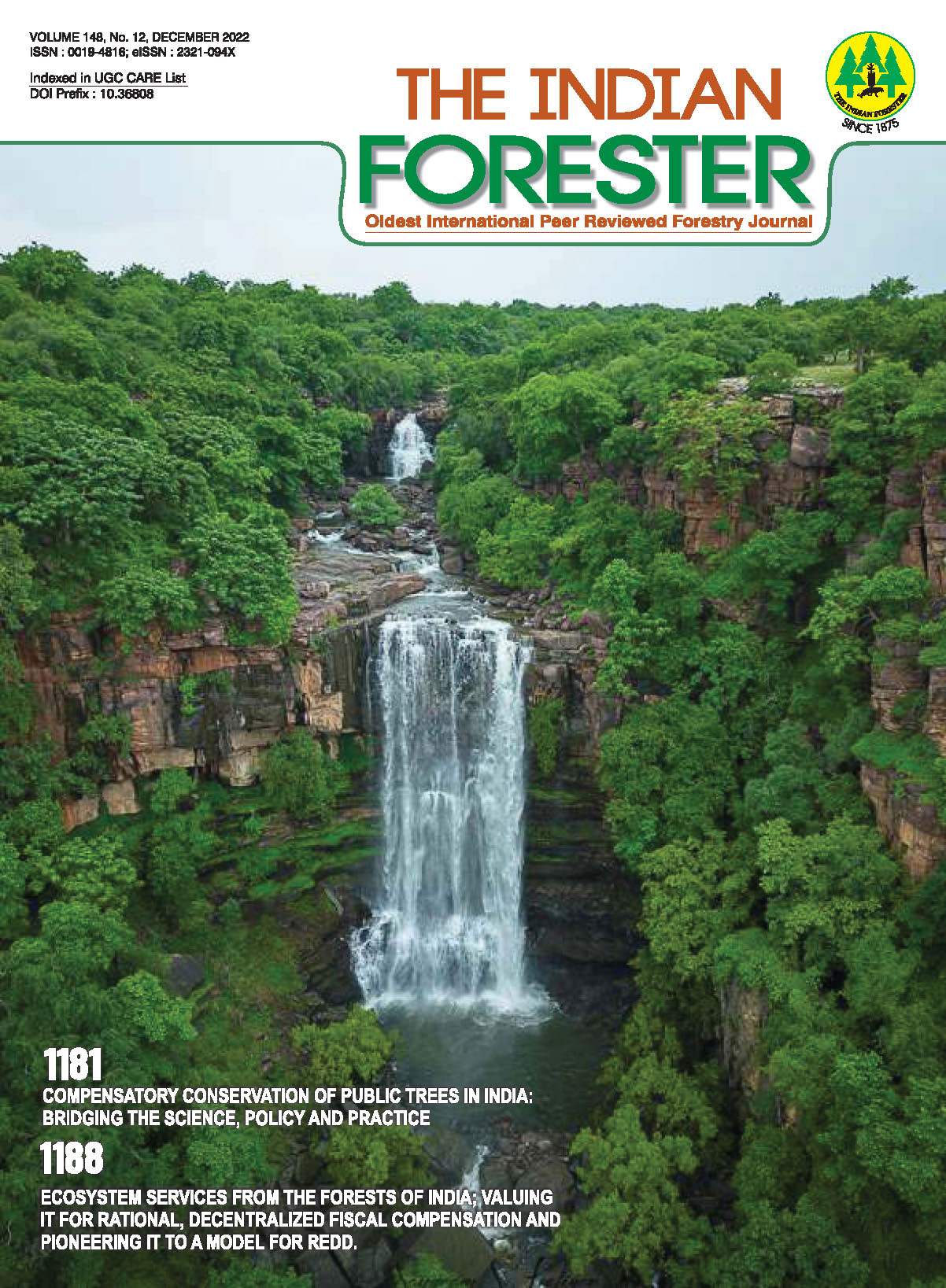Stand density and crown growth assessment of Anogeissus pendula Edgew in Tropical dry deciduous forests of Rajasthan (India)
DOI:
https://doi.org/10.36808/if/2022/v148i12/165969Keywords:
Structure, Density, Basal area, Height, CrownAbstract
The present studies were carried out to assess the stand and crown growth of Anogeissus pendula (Dhav) in tropical dry deciduous forest at Jhalawar Forest Division, Rajasthan, India. Density of each site was determined by calculating the number of trees and basal area per hectare of the site. The results revealed that the Mishroli (S3) performed highest for growth parameters viz., dbh (26.20 cm), height (11.65 m), basal area (17.2 m2/ha), volume (37.73 m3/ha) and crown height (2.48 m) with lowest density (362.50 tree/ha), whereas, minimum has been observed for the same parameters at Bagher (S1)with highest density (535 trees/ha) and reverse is true for form factor (0.18) at above sites. Performance at Mishroli (S3) has been attributed to lower density, trees of higher diameter class indicates its site as good site quality compared to others. The poor performance at S1was attributed to high level of disturbance as observed in field. The crown level stand structure at S3 reported good performance for the parameters viz., crown width (8.89 m), crown length (9.46 m), crown basal area (63.62 m2/tree), crown index (1.07), crown percent (80.79 %), crown surface area (149.18 m2/tree). Crown projection ratio (44.99) and crown quotient to ground cover (3782.78) reported highest at Ghatoli (S4) and minimum (34.53) and (1213.02) at Mishroli (S3), due to high density level causing low mean dbh at S4 relatively to Mishroli (S3).
References
Assmann E. (1970).The principles of forest yield study. New York: Pergamon Press. 506p.
Avery T E. and Burkhart H. E. (1983). Forest Measurements. New York: Mc Graw Hill.290p.
Anonymous (2006). Wealth of India, Raw Materials, CSIR, New Delhi, 1(A): pp 296-302.
Bhargava O.P.(1951) Anogeissus pendula in Madhya Bharat.Proc. "11th Silvi.conf Part 11, FRI Dehradun. pp. 490 - 497.
Bitterlich W. (1984) The Relaskopidea slough: Commonwealth Agricultural Bureaux. Farnham Royal, England. 242p.
Champion H G and Seth S K (1968). A revised survey of the forest types of India. Government of India Publications
Chaturvedi A N and Khanna L S. (1982) Forest Mensuration.International Book Distributors, Dehra Dun, India. 403p.
Dwivedi A. P. (1992) Agroforestry : Principles and Practices. Oxford & IBH Publishing co Pvt. Ltd. pp. 215 - 289.
Hocking D. (1993) Trees of Drylands. Oxford and IBH Publishing company Pvt. Ltd., New Delhi. pp. 107 - 108.
Krajicek J E, Brinkman K A and Gingrich S F. (1961) Crown competition – a measure of density.Forest Sciences.7: 35-42.
Mathur C M (1961) Artificial regeneration of Anogeissus pendula. Proc. X Silvic. Conf., FRI, Dehra Dun. pp. 365
Mathur, C.M. (1965) Nursery techniques and afforestation trials with A. pendula.Indian Forester91 (2) : 99 - 103.
Pearson R. S. and Brown H. P. (1932). Commercial timber of India, Vol. 1 central publication branch, Calcutta.
Poonia P.K., Subba S., Nilajagi M.S.and Hanumantha M. (2020).Tree Diversity and Carbon Stock Assessment of College Campus Sirsi, Karnataka (India). Indian Forester, 146 (5) : 419-424
Popoola, F. S. and Adesoy, P. O. (2012). Crown ratio models for Tectonagrandis(Linn. f) stands in Osho forest reserve, Oyo state, Nigeria. Journal of Forest Science.28(2): 63-67.
Prahlad, V.C. (2018). Stand Structure and Growth Pattern of Deodar (Cedrus deodara Roxb. Loud) Forests of Western Himalaya (India). Int.J.Curr.Microbiol.App.Sci. 7(07): 1737-1745. doi: https://doi.org/10.20546/ijcmas.2018.707.206
Pressler M. 1865. Das Gesetz der stambidung. Leipzig. 153p.
Saxena S.K. (1989). An ecological study of Anogeissus pendula Edgew. with special reference to seed germination and silvicultural treatments. Ph.D. thesis Bundelkhanduniversity Jhansi. pp. 15 - 40.
Sharma Y. (2006). Studies on stand parameters and natural regeneration status of silver fir and spruce in Himachal Pradesh. M.Sc. Thesis, Dr. Y. S. Parmar University of Horticulture and Forestry, Nauni, Solan, H.P., India. 84p.
Sharma A.K and Bhatt V.K. (1994 a). Natural regeneration of tree species of Research farm at Datia under protected condition, Annual Report, CSWCR and Tl, Dehradun. pp. 136.
Singh P. (1982). Studies on growth-behaviour of Anogeissus pendula in Rajasthan. Indian Forester 108(8): 574-580.
Singh S P. (1977). Stem volume prediction model for variable diameter limits. Indian Forester.103(1-12): 23-28.
Thorpe H C, Astrup R, Trowbridge A and Coates K D. (2010). Competition and tree crowns: A neighbourhood analysis of three boreal tree species. Forest Ecology and Management.259: 1586-1596.
Troup R S. (1921). Silviculture of Indian Trees.Vol.III, Clarendon Press, Oxford: 1905-1132.
Verma, S.K. (1972 a). The ecology of the A. pendula forests (of Rajasthan, Central India) Bois et Forets Des Tropiques 144: 17 - 28.
Working plan (2013-14 to 2022-23).Jhalawar Forest Division, Govt. of Rajasthan, India.
Yadav A S (2012). Woody vegetation of the different forest area in the Alwar district of Rajasthan. J. Phyto. Res 25(2): 177-182.
Downloads
Downloads
Published
How to Cite
Issue
Section
License
Unless otherwise stated, copyright or similar rights in all materials presented on the site, including graphical images, are owned by Indian Forester.





